The Best Shoes for Meetings Professionals
As an event planner, you’re on your feet for hours on end, often navigating various terrains and dealing with unexpected physical challenges like moving furniture and unpacking large boxes. While the adrenaline of executing a perfect event can be exhilarating, the wear and tear on your body—especially your feet—can take a significant toll from head to, well, toe. In this article, we’ll investigate what faulty footwear can do to your feet and help you find shoes that put you in better standing at all your events.
What Bad Footwear Does to Your Body—And Mind
Ill-fitting shoes can cause blisters, bunions, corns, and calluses. Over time, they can also lead to more severe problems like hammertoes and plantar fasciitis. “Furthermore, prolonged wearing of uncomfortable and non-supportive shoe gear increases the risk of biomechanical deformities that may affect an individual’s physical activity level and lifestyle,” says podiatrist Sindhu Srinivas, DPM, who is based in Atlanta.
Lack of proper support can also strain your ankles, knees, hips, and lower back, leading to chronic pain and potentially long-term damage. Tight or poorly designed shoes may also affect your vascular system, restricting blood flow, causing swelling and increasing the risk of conditions like varicose veins.
And that’s just the physical effects! As anyone who has ever spent a minute in uncomfortable footwear can attest, it can also impact your mental state tremendously, leading to decreased productivity, irritability (a major liability during high-pressure situations), and even reduced confidence, making it harder to engage with clients and execute your vision with authority.
We turned to Srinivas for pointers on finding suitable event footwear options, no matter your personal style.


Sneakers: The All-Rounder
The days of formal footwear are (mostly) over. For event planners, stylish sneakers, as opposed to running shoes, are perfectly acceptable given today’s trend toward business casual. (Marriott has even unveiled a branded white leather sneaker for planners[1] , which made its debut at the recent Global Business Travel Association (GBTA) conference.) And that’s good news since sneakers are generally a safe option for your feet. When selecting them, be sure to look for:
● Good arch support to distribute weight evenly and reduce stress on your feet.
● Adequate cushioning to absorb shock, protecting your joints and reducing fatigue.
● Breathable materials that allow air to get to your feet, reducing the risk of blisters and fungal infections.
● Durable, high-quality materials that can withstand long hours of use.
● A firm foundation: Srinivas suggests testing the shoe’s foundation by trying to bend the shoe at the toe box. “If the shoe folds easily, it may not provide solid foundation or support,” she says.
Boots: Rugged and Reliable
Boots, particularly hiking boots, are ideal for outdoor events, or when you need extra support. The key features to look for include:
● A supportive ankle to prevent twists and sprains. “It may be beneficial to choose high-top boots, which enclose and provide stability to the ankle joint. This may reduce incidence of sprains, falls, discomfort, and instability,” Srinivas says.
● Waterproof material to keep your feet dry and comfortable in various weather conditions.
● Good traction to prevent slips on uneven or slick surfaces.
● Sufficient padding and arch support to keep you comfortable throughout the day.
Heels: Elevated Elegance
While heels can add a professional and stylish touch, and may still be a go-to for evening events, they can also cause serious pain and damage if not chosen wisely. When picking heels, opt for:
● Heels no higher than 2-3 inches with a thicker base to reduce strain on your feet and lower back.
● Cushioned insoles to give you extra comfort and support.
● A wide toe box to prevent pinching and allow your toes to move freely.
● Wedges with ankle straps and an open toe box (as an alternative to traditional heels). “Ankle straps will support the joint while preventing excessive movement,” Srinivas says.
Comfort Shoes: The Best of Both Worlds
Comfort shoes combine style and support, making them ideal for long days on your feet. When selecting comfort shoes, choose:
● Ergonomic designs, which follow the natural contours of your feet, providing support where needed.
● Adjustable straps or laces to ensure a snug fit.
● Shock absorption to reduce impact on your joints.
● Breathable materials to keep your feet cool and dry.
The kicker: Srinivas recommends having your feet measured prior to purchasing any shoes you’ll be wearing for long stretches at a time to guarantee a proper fit, as your feet change size throughout your life.


The following brands do not participate in Marriott Bonvoy™ Events: Design Hotels, Marriott Executive Apartments, Residence Inn, TownePlace Suites, StudioRes, Bulgari Hotels & Resorts, The St. Regis Residence Club, The Phoenician Residences, a Luxury Collection Residence Club, Scottsdale, The Ritz-Carlton Club, The Ritz-Carlton Yacht Collection, and Homes & Villas by Marriott Bonvoy. For a full list of participating and non-participating brands, please click here.